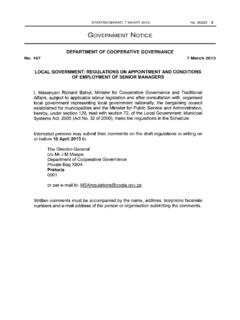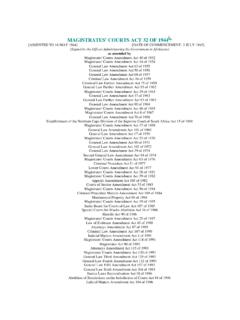Transcription of South African Budget Process - PMG
1 South African Budget Process 24 October 2011 1 Overview of the Budget The Budget is a Process through which choices have to be made about competing priorities Allocative efficiency, fiscal stability and service delivery are key in budgeting Budgeting is a political exercise that starts with political choices about priorities and ends with political choices about which programmes and projects get funded The three interrelated spheres of government should cooperate in delivering concurrent functions The vertical division of revenue shows resources allocated to the three spheres South Africa uses a three-year rolling Budget system, informed by key government priorities, strategic plans of departments and the fiscal stance The Constitution provides Parliament with powers to amend the Budget realised through the Money Bills Amendment Procedure and Related Matters Act, 2009 2 Overview of the Budget cont.
2 Government s outcomes approach provides a framework for results-driven performance South Africa s Budget Process is undergoing reform, shaped in part by the outcomes approach and by the Money Bills Amendment Procedure and Related Matters Act, 2009 For budgeting purposes, votes and their entities have been organised by function across the three spheres, allowing for a more effective comparison of allocations with service delivery trends For the Budget to meet it s objectives, it must be as comprehensive in covering the public sector as possible - This includes: public entities and state owned enterprises Departments in the three spheres Donor receipts (both cash and in-kind) This new functional approach allows for proper resources allocation in line with this 4 The medium term expenditure framework 2011/12 2012/13 2013/14 2011 MTEF Changes to baseline Revised macroeconomic and fiscal framework 3rd year = forecast inflationary increase on 2nd year Reduction in respect of once-off items and to effect savings and reprioritisation 2012/13 2013/14 2014/15 2012 MTEF 5 Role-players in the Budget Process Cabinet Ministers Committee on the Budget Budget Council (Minister and provincial MECs for Finance) Budget Forum ( Budget Council plus local government)
3 Intergovernmental technical forums Departments Relevant entities and Donors Financial and Fiscal Commission Legislatures Portfolio Committees, Finance Committees, Appropriations Committees Budget cycle Departments submitted their estimates of expenditure for the 2012 Medium Term Expenditure Framework within the 2011 Budget baseline and then with proposals for increasing estimates The medium term expenditure committee (MTEC), an interdepartmental committee, considers the allocation of funds in respect of each functional grouping MTEC makes recommendations to Ministers Committee on the Budget Then recommendations are taken to Cabinet Medium Term Budget Policy Statement tabled in October, including the vertical division of revenue proposal for the 2012 MTEF Adjustments estimates Process is based on Section 30 (1) and (2) of the PFMA and is also tabled in October Allocation letters for the 2012 MTEF are sent out in November, including the provision for earmarking certain amounts or set conditions Budget documents are then prepared 6 Money Bills Amendment Act The Money Bills Amendment Procedure and Related Matters Act, 2009 puts in place the procedure to amend money bills, as per Sec 77(3) of the Constitution.
4 It defines the processes and procedures that will be undertaken to pass the Budget The Process starts in the year prior to the tabling of the Budget , when each parliamentary committee tables a Budget Review and Recommendation Report (BRRR) These reports evaluate the performance of each government department and must be referred to the Minister of Finance and the relevant Minister by Parliament The recommendations in these reports act as an early warning system regarding the issues that Parliament is concerned about When the Finance Minister tables the Budget he must table a report indicating how the Division of Revenue and the Budget gives effect to the recommendations made in the reports If the Minister s explanation does not address Parliament s concerns, they can amend the Budget in order to give effect to their proposals 7 Budget cycle key milestones Policy review Departmental planning Parliament and budgeting April June July Aug Sept Oct Review.
5 Evaluate and decide on new major policy proposals Propose fiscal and Budget framework, and division of resources Executive/s consider frameworks and division of resources Table Medium Term Budget Policy Statement Departments prepare Budget , including detailed spending plans for new proposals Intergovernmental and technical forums Sector and focused Budget hearings Division of Revenue Act passed Appropriation Bill and Revenue Bills passed 8 Budget cycle key milestones cont. Policy review Departmental planning Parliament and budgeting Nov Dec Jan Feb March Cabinet approves new MTEF allocations National Budget tabled (includes response to BRRR) Provincial budgets are tabled (14 days after National Budget is tabled) Departments revise medium term plans and finalise Budget inputs Portfolio committees submit BRRR reports, adopt fiscal framework.
6 Pass Money Bills Adoption of fiscal framework Departments revise medium term plans and finalise Budget inputs Strategic Plans tabled 9 THANK YOU 10 Adjusted Estimates of National Expenditure 2011 and 2011 Adjustments Appropriation Bill 24 October 2011 AENE Introduction The annual Budget Process and adjustments Summary of adjustments for the financial year Summary tables 2011/12 adjusted national Budget Adjusted appropriations per vote and adjusted estimates of direct charges against the National Revenue Fund Adjusted appropriations per economic classification Roll-overs Unforeseeable and unavoidable expenditure Adjustments due to significant and unforeseeable economic and financial events Self-financing expenditure Declared savings and projected underspending Expenditure outcome 2010/11 and preliminary expenditure 2011/12 Adjusted departmental receipts Information in each chapter 12 AENE layout One chapter per vote 38 votes Votes arranged according to functional groupings Functional groupings: Central Government Administration Financial and Administrative Services Social Services Justice, Crime Prevention and Security Economic Services and Infrastructure 13 Information contained in each chapter Adjusted Budget summary 14 2011/12 R thousand Main appropriation Adjusted appropriation Decrease Increase Amount to be appropriated of which: Current payments Transfers and subsidies Payments for capital assets Payments for financial assets Direct charge against the National Revenue Fund Executive authority Accounting officer Website address Adjusted Budget summary Main appropriation: total amount voted in the main Budget Adjusted appropriation.
7 Adjusted total amount to be voted effect of the main appropriation and the adjustment Decrease/ Increase: amount of the adjustment itself Disaggregated into: Current payments: payments made for operational requirements Transfers and subsidies: payments made for which the department does not directly receive anything in return Payments for capital assets: payments for an asset that can be used for more than one year and from which future economic benefits or service potential are expected to flow Payments for financial assets: mainly consist of payments made by departments as loans to public corporations or as equity investments in public corporations Direct charge against the National Revenue Fund: an amount spent in terms of statutes, direct charges do not require parliamentary approval Accountability information: the vote s executive authority, accounting officer and website address 15 Aim and programme changes Aim: department s mandate, strategic objectives or administrative functions Changes to programme purposes, objectives and measures: are shown to maintain the link between a department s strategic and annual performance plan, its voted Budget and its adjusted Budget 16 Mid-year performance status 17 Indicator: numerical measure that tracks a department s progress towards its goal, it may measure inputs, activities, outputs, outcomes or in certain instances explanatory information relating to the internal or external environment Programme: links the indicator to the vote programme associated with it Projected for 2011/12 as published in the 2011 ENE.
8 States what the department projected it would achieve Indicator Programme Annual performance As published in the 2011 ENE Programme linked to the indicator Projected for 2011/12 as published in the 2011 ENE Achieved in the first six months of 2011/12 (April to September) Changed estimate for 2011/12 Mid-year performance status cont. Achieved in the first six months of 2011/12: What the department has actually achieved Changed estimate for 2011/12: Changed from the estimate originally published. Estimates will typically change in cases where the funding provided for a particular programme has been amended in the Adjustments Appropriation Bill owing to changes in mandate / policy / Budget programme structure or to expenditure adjustments Changes to indicators and targets published in the 2011 ENE: significant deviations from specific performance estimates are explained below the table, as well as any changes to the indicators themselves Mid-year progress.
9 Discussion on the department s progress towards achieving the targets that were set 18 Vote AENE 19 Programme 2011/12 Adjustments appropriation Total Main Roll- Unforeseeable/ Virements Other adjustments Adjusted R thousand appropriation overs unavoidable and shifts adjustments appropriation appropriation Programme name Subtotal Direct charge against the National Revenue Fund Item Total Economic classification Current payments Economic classification item Transfers and subsidies Economic classification item Payments for capital assets Economic classification item Payments for financial assets Total Vote AENE cont. Adjusted estimates of expenditure set out by the type of expenditure adjustment, and by vote programme and by economic classification Main appropriation: total amount voted in the main Budget Adjustments appropriation: amounts of the adjustment for each of the types of expenditure adjustment by programme and economic classification Roll-overs: unspent funds from the preceding financial year reallocated to the current financial year to finalise activities close to completion Unforeseeable/unavoidable: spending that could not be anticipated at the time of finalising the main Budget Virements: utilisation of savings or underspending from amounts appropriated under one main division (programme) towards the defrayment of increased expenditure under another main division within the same vote 20 Shifts.
10 Utilisation of savings or underspending towards the defrayment of increased expenditure within a main division (programme) of a vote, between different segments of the main division (subprogrammes and economic classifications). Shifts include the reallocation of any funds which may have been incorrectly allocated in the ENE Process Other adjustments: include function shifts; unallocated amounts announced in the main Budget ; adjustments due to significant and unforeseeable economic and financial events; emergencies funding; self-financing expenditure; and declared savings Total adjustments appropriation: sum of all the expenditure adjustments by programme and economic classification Adjusted appropriation: the adjusted total amount to be voted for the current financial year Similar tables are then shown for each programme which has adjustments to appropriations by subprogramme and economic classification 21 Vote AENE cont.










